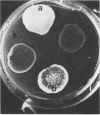Abstract
The relationship of capsular types of Staphylococcus aureus to type of infection, carrier state, and phage type was studied in a collection of 477 isolates from 380 infection sites. Capsular polysaccharides were demonstrated by precipitation and agglutination with 11 monospecific antisera. When only one isolate from each infection was considered, 63% were of type 8 and 16% were of type 5. Of all the isolates tested, over 90% were encapsulated. We did not demonstrate any marked difference in the distribution of capsular types between isolates from the blood stream or purulent processes and isolates from healthy carriers or food. Most isolates from bovine mastitis milk had nontypeable capsules. The capsular type seemed stable in culture, and encapsulation had no apparent influence on susceptibility to phages. Of 27 phage-propagating strains maintained via culture transfer on artificial media over many years, 16 (59%) produced capsules. A striking association between certain phage patterns and capsular types was demonstrated.
Full text
PDF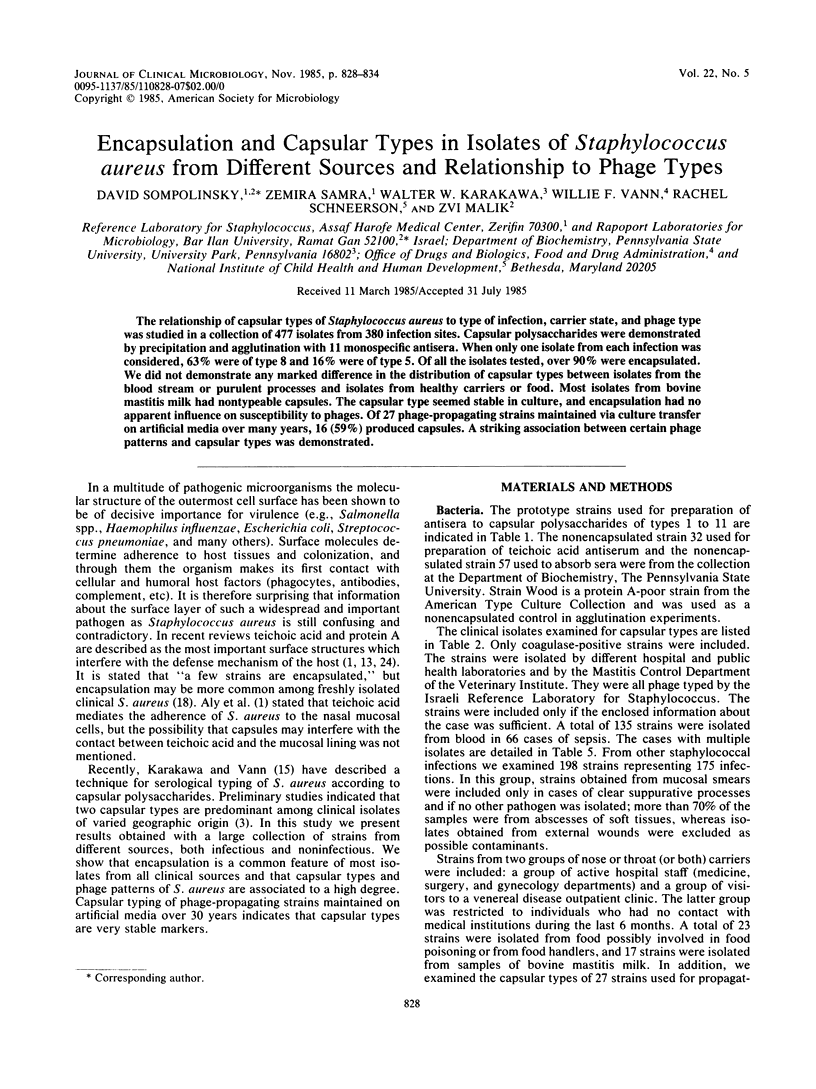
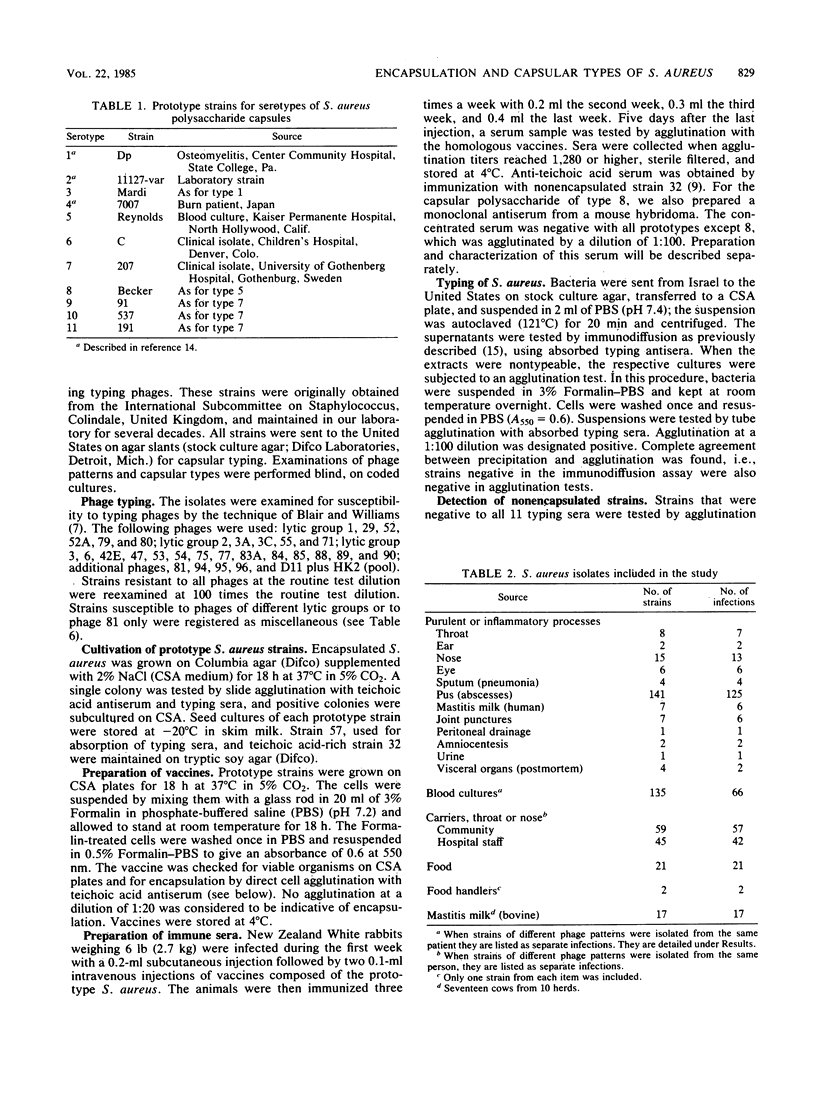
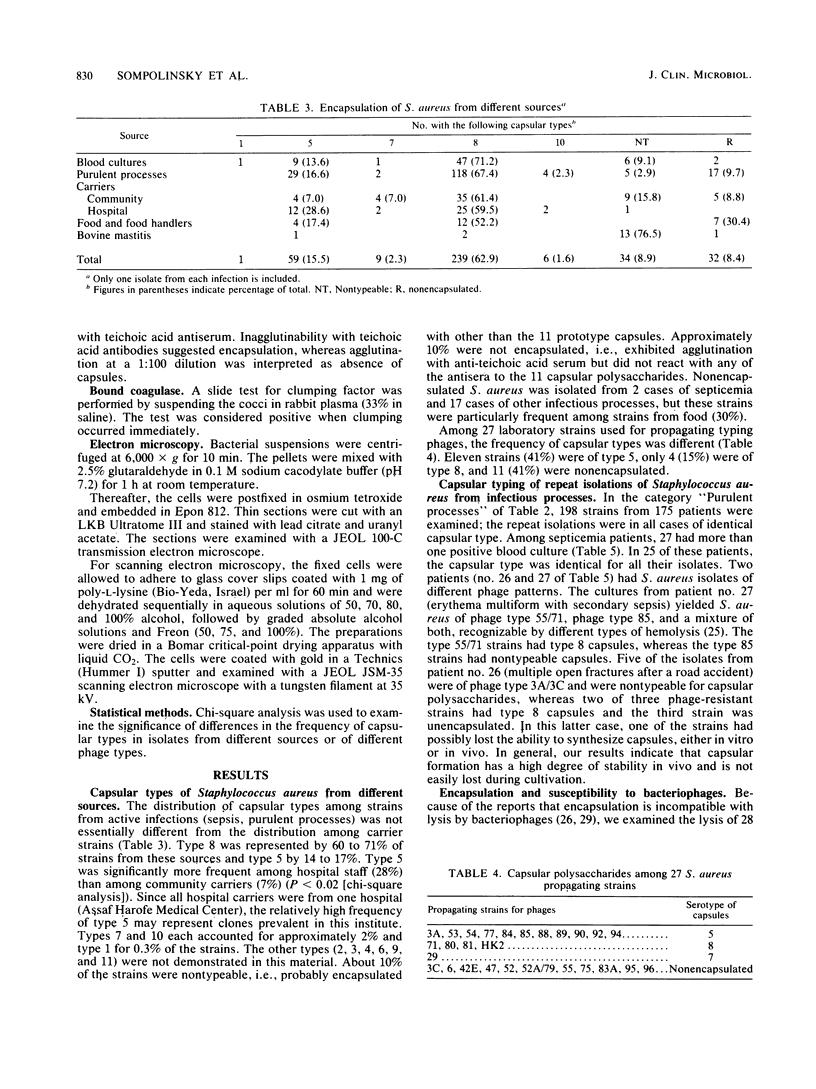
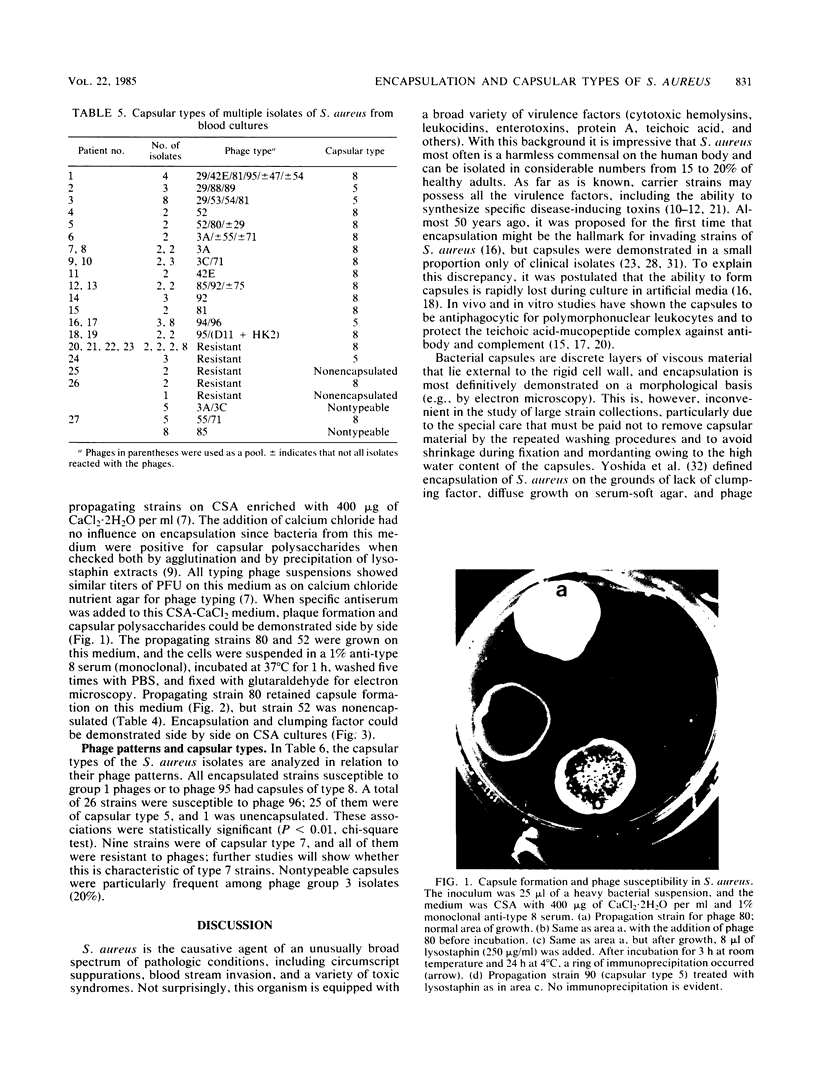
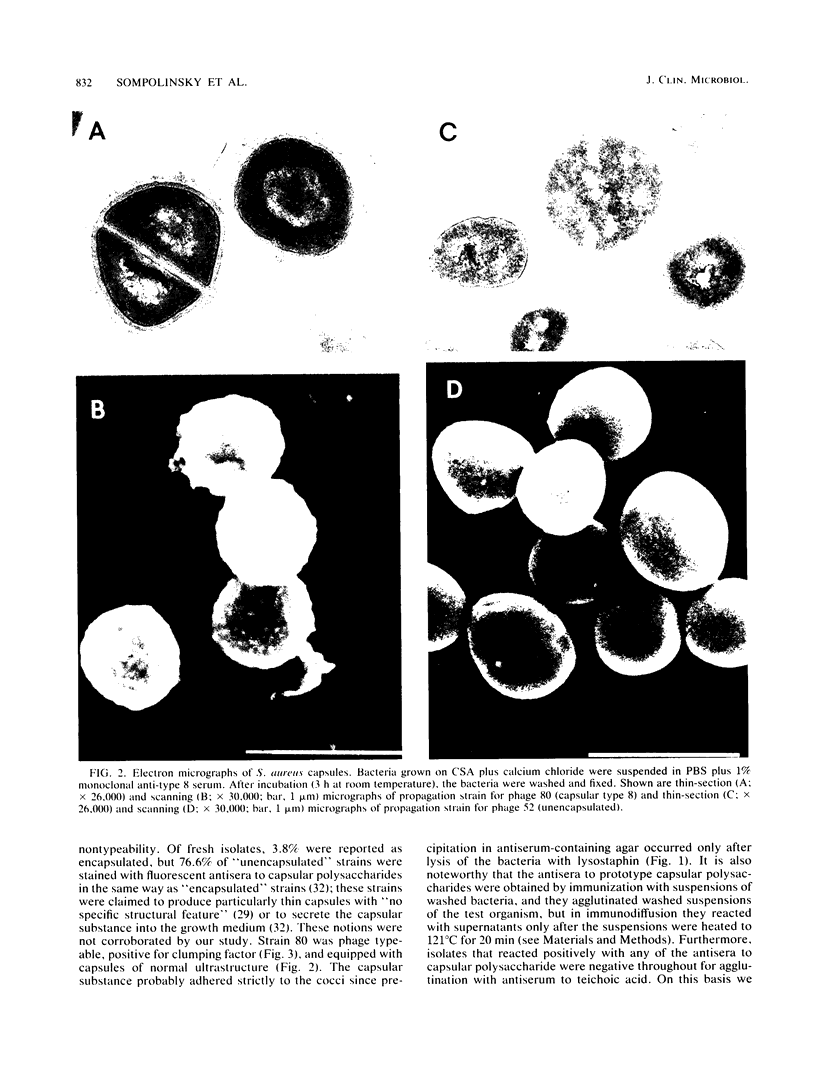
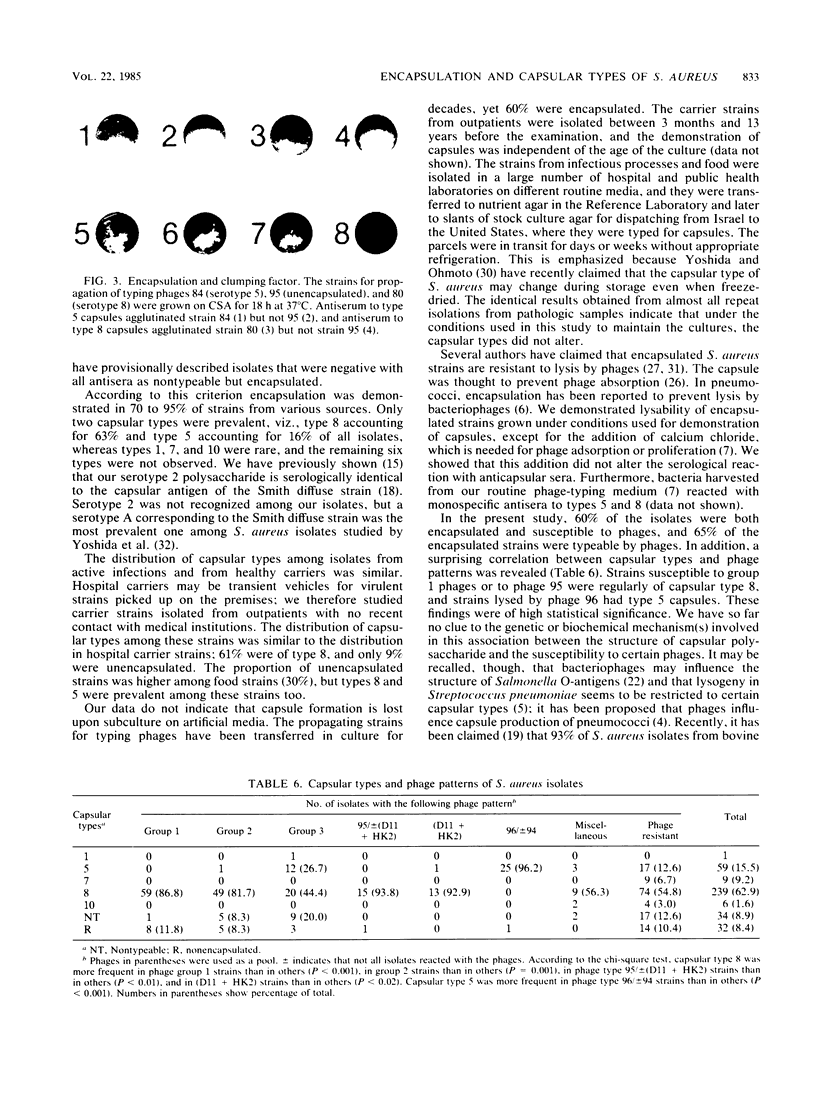
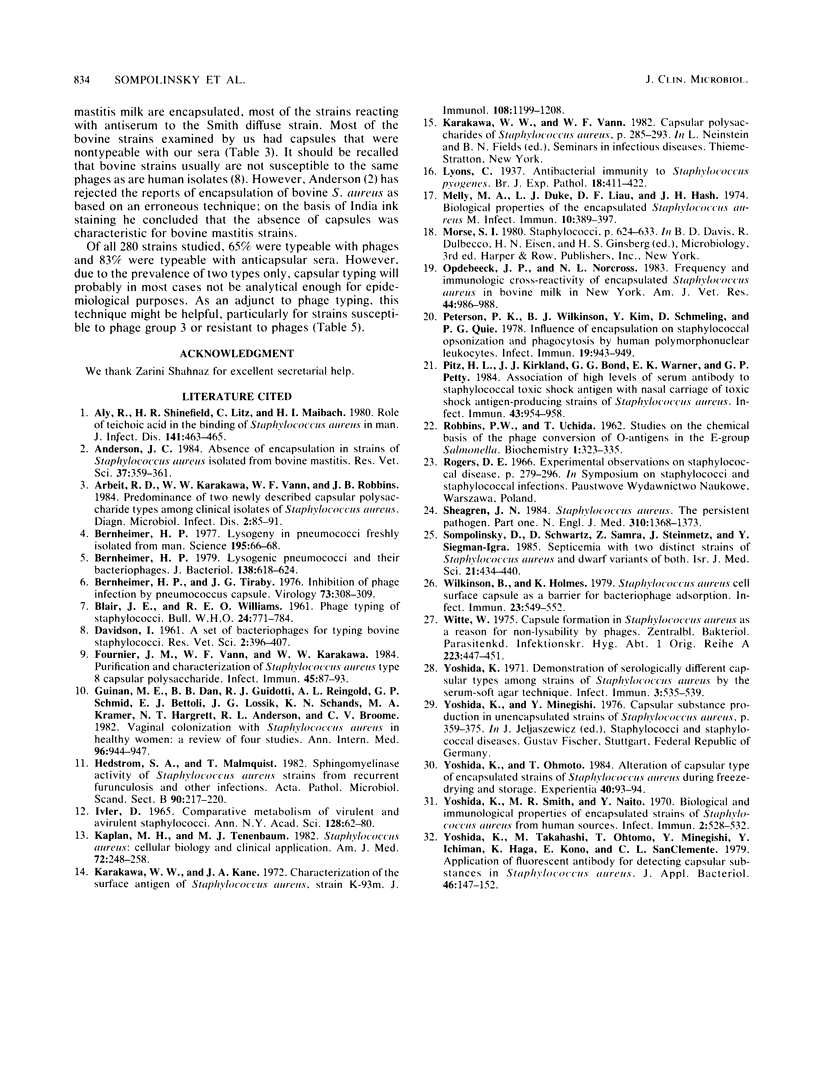
Images in this article
Selected References
These references are in PubMed. This may not be the complete list of references from this article.
- Aly R., Shinefield H. R., Litz C., Maibach H. I. Role of teichoic acid in the binding of Staphylococcus aureus to nasal epithelial cells. J Infect Dis. 1980 Apr;141(4):463–465. doi: 10.1093/infdis/141.4.463. [DOI] [PubMed] [Google Scholar]
- Anderson J. C. Absence of encapsulation in strains of Staphylococcus aureus isolated from bovine mastitis. Res Vet Sci. 1984 Nov;37(3):359–361. [PubMed] [Google Scholar]
- Arbeit R. D., Karakawa W. W., Vann W. F., Robbins J. B. Predominance of two newly described capsular polysaccharide types among clinical isolates of Staphylococcus aureus. Diagn Microbiol Infect Dis. 1984 Apr;2(2):85–91. doi: 10.1016/0732-8893(84)90002-6. [DOI] [PubMed] [Google Scholar]
- Bernheimer H. P. Lysogenic pneumococci and their bacteriophages. J Bacteriol. 1979 May;138(2):618–624. doi: 10.1128/jb.138.2.618-624.1979. [DOI] [PMC free article] [PubMed] [Google Scholar]
- Bernheimer H. P. Lysogeny in pneumococci freshly isolated from man. Science. 1977 Jan 7;195(4273):66–68. doi: 10.1126/science.12565. [DOI] [PubMed] [Google Scholar]
- Bernheimer H. P., Tiraby J. G. Inhibition of phage infection by pneumococcus capsule. Virology. 1976 Aug;73(1):308–309. doi: 10.1016/0042-6822(76)90085-4. [DOI] [PubMed] [Google Scholar]
- Fournier J. M., Vann W. F., Karakawa W. W. Purification and characterization of Staphylococcus aureus type 8 capsular polysaccharide. Infect Immun. 1984 Jul;45(1):87–93. doi: 10.1128/iai.45.1.87-93.1984. [DOI] [PMC free article] [PubMed] [Google Scholar]
- Guinan M. E., Dan B. B., Guidotti R. J., Reingold A. L., Schmid G. P., Bettoli E. J., Lossick J. G., Shands K. N., Kramer M. A., Hargrett N. T. Vaginal colonization with Staphylococcus aureus in healthy women: a review of four studies. Ann Intern Med. 1982 Jun;96(6 Pt 2):944–947. doi: 10.7326/0003-4819-96-6-944. [DOI] [PubMed] [Google Scholar]
- Hedström S. A., Malmqvist T. Sphingomyelinase activity of Staphylococcus aureus strains from recurrent furunculosis and other infections. Acta Pathol Microbiol Immunol Scand B. 1982 Jun;90(3):217–220. doi: 10.1111/j.1699-0463.1982.tb00108.x. [DOI] [PubMed] [Google Scholar]
- Ivler D. Comparative metabolism of virulent and avirulent staphylococci. Ann N Y Acad Sci. 1965 Jul 23;128(1):62–80. doi: 10.1111/j.1749-6632.1965.tb11630.x. [DOI] [PubMed] [Google Scholar]
- Kaplan M. H., Tenenbaum M. J. Staphylococcus aureus: cellular biology and clinical application. Am J Med. 1982 Feb;72(2):248–258. doi: 10.1016/0002-9343(82)90817-8. [DOI] [PubMed] [Google Scholar]
- Karakawa W. W., Kane J. A. Characterization of the surface antigens of Staphylococcus aureus, strain K-93M. J Immunol. 1972 May;108(5):1199–1208. [PubMed] [Google Scholar]
- Melly M. A., Duke L. J., Liau D. F., Hash J. H. Biological properties of the encapsulated Staphylococcus aureus M. Infect Immun. 1974 Aug;10(2):389–397. doi: 10.1128/iai.10.2.389-397.1974. [DOI] [PMC free article] [PubMed] [Google Scholar]
- Opdebeeck J. P., Norcross N. L. Frequency and immunologic cross-reactivity of encapsulated Staphylococcus aureus in bovine milk in New York. Am J Vet Res. 1983 Jun;44(6):986–988. [PubMed] [Google Scholar]
- Peterson P. K., Wilkinson B. J., Kim Y., Schmeling D., Quie P. G. Influence of encapsulation on staphylococcal opsonization and phagocytosis by human polymorphonuclear leukocytes. Infect Immun. 1978 Mar;19(3):943–949. doi: 10.1128/iai.19.3.943-949.1978. [DOI] [PMC free article] [PubMed] [Google Scholar]
- ROBBINS P. W., UCHIDA T. Studies on the chemical basis of the phage conversion of O-antigens in the E-group Salmonellae. Biochemistry. 1962 Mar;1:323–335. doi: 10.1021/bi00908a020. [DOI] [PubMed] [Google Scholar]
- Ritz H. L., Kirkland J. J., Bond G. G., Warner E. K., Petty G. P. Association of high levels of serum antibody to staphylococcal toxic shock antigen with nasal carriage of toxic shock antigen-producing strains of Staphylococcus aureus. Infect Immun. 1984 Mar;43(3):954–958. doi: 10.1128/iai.43.3.954-958.1984. [DOI] [PMC free article] [PubMed] [Google Scholar]
- Sheagren J. N. Staphylococcus aureus. The persistent pathogen (first of two parts). N Engl J Med. 1984 May 24;310(21):1368–1373. doi: 10.1056/NEJM198405243102107. [DOI] [PubMed] [Google Scholar]
- Sompolinsky D., Schwartz D., Samra Z., Steinmetz J., Siegman-Igra Y. Septicemia with two distinct strains of Staphylococcus aureus and dwarf variants of both. Isr J Med Sci. 1985 May;21(5):434–440. [PubMed] [Google Scholar]
- Wilkinson B. J., Holmes K. M. Staphylococcus aureus cell surface: capsule as a barrier to bacteriophage adsorption. Infect Immun. 1979 Feb;23(2):549–552. doi: 10.1128/iai.23.2.549-552.1979. [DOI] [PMC free article] [PubMed] [Google Scholar]
- Witte W. Kapselbildung bei Staphylococcus aureus als Ursache für die Nicht-Typisierbarkeit durch Phagen. Zentralbl Bakteriol Orig A. 1975 Dec;233(4):447–451. [PubMed] [Google Scholar]
- Yoshida K. Demonstration of Serologically Different Capsular Types Among Strains of Staphylococcus aureus by the Serum-Soft Agar Technique. Infect Immun. 1971 Apr;3(4):535–539. doi: 10.1128/iai.3.4.535-539.1971. [DOI] [PMC free article] [PubMed] [Google Scholar]
- Yoshida K., Ohtomo T. Alteration of capsular type of encapsulated strains of Staphylococcus aureus during freeze-drying and storage. Experientia. 1984 Jan 15;40(1):93–94. doi: 10.1007/BF01959120. [DOI] [PubMed] [Google Scholar]
- Yoshida K., Takahashi M., Ohtomo T., Minegishi Y., Ichiman Y., Haga K., Kono E., San Clemente C. L. Application of fluorescent antibody for detecting capsular substances in Staphylococcus aureus. J Appl Bacteriol. 1979 Feb;46(1):147–152. doi: 10.1111/j.1365-2672.1979.tb02592.x. [DOI] [PubMed] [Google Scholar]



